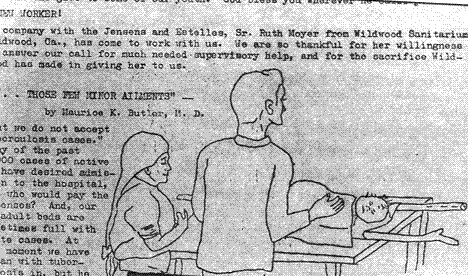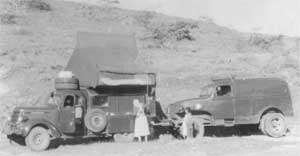(snapshot dated March, l962)

Part of an old Newsletter

Part of an old Newsletter
In l959 the Comstocks began issuing a monthly Newsletter, usually consisting of one or two legal-size sheets of mimeographed paper detailing such items as the names and homes of people who had recently visited the clinic, what progress had been made in the building program, and what was needed from those supporters in the U. S. who might be disposed to help. Already in the early 60's the Comstocks were realizing that the history of their clinic made a good story. With each Newsletter they included a brief "chapter" describing an event or circumstance that somehow had influenced Yerba Buena's development. Here is a fine example of one of those stories, written by Marie Comstock, copied from an old Newsletter blotched with mimeograph ink and obviously typed on an ancient but dependable manual typewriter:
Arriving at Yerba Buena in the afternoon of Nov. 23, l954, to begin work we looked around for a place to set up our camp. It was still the rainy season so we couldn't get very far away from the road with the pickup. After scouting around we decided that the only place we could get the car off the road going down to Santa Cruz was an old section of road which was so steep that it had been abandoned but was still rocked so the car would not mire down.
Going up this old road about 200 feet we found a fairly level spot near where we built our first permanent building. This building was first the schoolhouse, then the Diaz home, then the Green home, for a short time the Walker home, and is now the Price home.

Setting up camp was not a very complicated operation in those days. We just parked the car, lifted up the tent on top of the cab over the back of the pickup making a sleeping quarters for 4 or 6 people (depending on their size). The heavy canvas which covered the tent when it was folded up, we then stretched out back of the pickup for a shelter from the rain... We think we had the wettest, coldest and windiest Dec., Jan., and Feb., that we have ever had, but it was probably only because we had to practically live out in the weather. The water oozed up through the mud floor of our one room and even though we covered the mud with more sawdust every few days we had to continually wear our rubber boots or galoshes to keep our feet dry.
We couldn't build a fire outside because everything was too wet and we couldn't have one inside our little room for fear of burning down our house, so we just shivered through the wet days and hoped for dry weather.
To us those first few months seemed rather primitive but we always felt better when someone from Pueblo Nuevo would come to visit and remark "You certainly have it nice here." We would realize then how cold some of these people live.